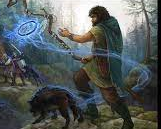In unoccupied spaces that you can see within your range, you summon fey creatures that appear. The type of creature that appears depends on what you choose as an option:
There is one fey creature of challenge rating 2 or lower
The challenge rating of two fey creatures must be one or less
There are four fey creatures of challenge rating 1/2 or lower
There are eight fey creatures with challenge ratings of 1/4 or less
It is impossible to summon a creature that disappears when it reaches 0 hit points or at the end of the spell.
You and your companions will be able to get along with the summoned creatures. When the summoned creatures have their own turn, the initiative will be rolled as a group. As long as you give them verbal commands, they will obey them (no action on your part is required). It is important to note that even if you do not issue any commands to them. They will defend themselves against hostile creatures, but otherwise will do nothing.
The GM has access to the creature’s statistics. In the following table you will find some examples of creatures that can be used.
At Higher Levels of Education. As soon as this spell is cast using certain higher-level spell slots. You can choose one of the summoning options above, and more creatures appear. Twice as many if you use a 6th-level spell slot and three times as many if you use an 8th-level spell slot.
Creatures sampled in this article
Creature Research Creature
Blink Dog and Sprite, 1/4
In the first half of the year
1 Dryad
2 Sea Hag
Here’s an interesting idea about using Conjure Woodland Beings in a non-combat setting.
Dryads and Quicklings are the only fey on CR 1, so if you choose CR 1 you’ve got a 1 in 2 chance of getting Dryads, unless the DM really does not want you to have Dryads, or if they just just let you choose Dryads.
It would be my preference to have the caster make a straight spellcasting check to try and influence the creature type, since they’re expending a valuable spell slot hoping for a certain outcome. The DC to get what they want could be 15, variable at the DM’s discretion. So there is a chance of failure, but there is also a chance of success).
So summon two Dryads if you have time. For a spell of 4th level, they each cast Goodberry three times, resulting in 60 points of healing. This is better than a 4th level Cure Wounds out of combat. And it does not burden the DM with a ton of creatures to keep track of during combat, which is what most druid conjuration spells do.
However, the downside of this is that your DM might not pick Dryads for you / will not let you choose Dryads / will pick Quicklings if you try to work the system. Because it cannot be cast as an action, it cannot be used as a mid-combat effect like Mass Cure Wounds. Definitely used before or after a battle. DMs like to choose creatures for conjuration spells, so you should ask your DM beforehand if you can choose the creatures. I think that DMs should give a little love when picking creatures to players who are not trying to throw 8 sprites into combat encounters.
Read also:
